Iceland - Environment

As far as the environment of Iceland is concerned, there have been . As for nvironment - international agreements, we have; .
About the environment of Iceland
| Climate | We have temperate; moderated by North Atlantic Current; mild, windy winters; damp, cool summers |
|---|---|
| Revenue from forest resources | |
| Revenue from coal | |
| Waste and recycling | Municipal solid waste generated annually: 225,300 tons (2024 est.) |
| Total renewable water resources | 170 billion cubic meters (2022 est.) |
| Major rivers (by length in km) | |
| Total water withdrawal | |
| Municipal | 80 million cubic meters (2022 est.) |
| Industrial | 198 million cubic meters (2022 est.) |
| Agricultural | 300,000 cubic meters (2022 est.) |
| Land Use | |
| Agricultural land | 16.2% (2023 est.) |
| Agricultural land: arable land | arable land: 1.2% (2023 est.) |
| Agricultural land: permanent crops | permanent crops: 0% (2022 est.) |
| Agricultural land: permanent pasture | permanent pasture: 15% (2023 est.) |
| Forest | 0.6% (2023 est.) |
| Other | 82.6% (2023 est.) |
| Urbanization | |
| Urban population | 94% of total population (2023) |
| Rate of urbanization | 0.74% annual rate of change (2020-25 est.) |
| Major urban areas (Pop) | 216,000 REYKJAVIK (capital) (2018). |
All Important Facts about Iceland
Want to know more about Iceland? Check all different factbooks for Iceland below.









